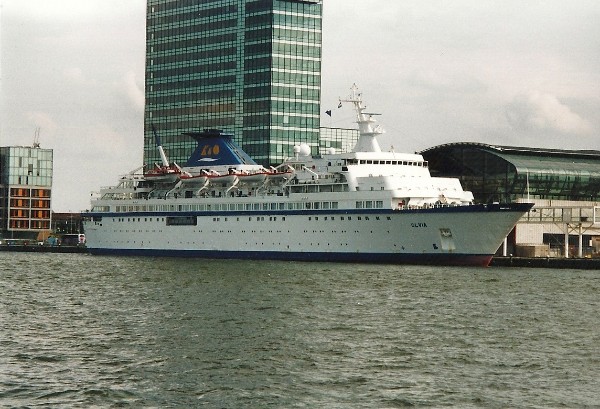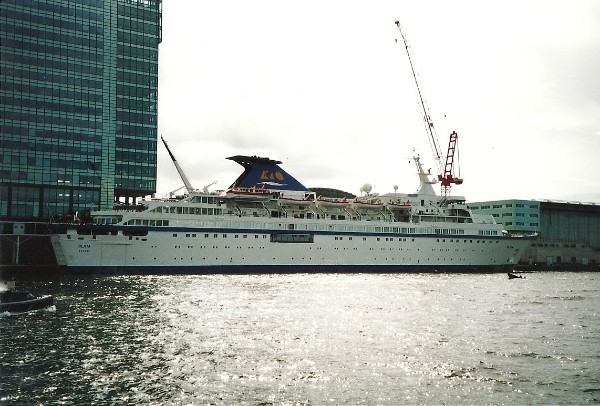Olvia
In the beginning of the 1970's, the Sovjet State ordered a series of ferries for the state-owned Black Sea Shipping Company. They were quite large for their purpose, ferryservices across the Black Sea, measuring around 16.000 tons. The ships had of course cardecks, but those were rather small and it was later on decided to mostly use them for cruises in the Black Sea as well as the Mediterranean. Several of the ships did sail ferryservices as planned, but this did not became their main focus. The first ship that was launched from the Wärtsilä yards at Abo, Finland (where all five ships of the class were built), was named Belorussiya. She was launched at the 6th of march 1974. Because she was the first ship in the class, the class was named the Belorussiya-class. She was followed in october 1974 by Gruziya, in april 1975 by Azerbaydzhan, in october 1975 by Kazakhstan and the last ship of the class was Kareliya, launched in april 1976. As you can see, all ships bore the names of republics within the Sovjet-Union as well as autonome regions.
The last ship of the class, Kareliya, was launched at the 14th of april 1976 from the Wärtsilä Yards at Abo (Turku) in Finland. The ship had been built under yardnumber 1223 and had a tonnagemeasurement of 16.631. Her lenght was 156,30 meters and she was 21,80 meters wide. Her twin screws were driven by two 18-cylinder geared diesel engines from Pielstick-Wärtsilä design. They gave her a normal sailing speed of around 21 knots. The ship had accomodation for 504 passengers in cabins and 505 deckpassengers when she was sailing ferryservices, but when she undertook cruises her passengernumber was 350 in one class. There were 191 crewmembers aboard and also, at her cardeck, the ship could carry 256 cars.
Below, the former Kareliya is shown under the name of Olvia when she visited Amsterdam at the 16th of august 2004. At the time, she was owned by Kaalbye Shipping Company and sailing in charter for Westline Cruises.

Kareliya was delivered to her owners in december of 1976 and mostly sailed cruises, although this was interrupted by several Black Sea ferry services. As a cruiseship, she was mainly used for the British-based CTC Cruises and she was not only limited to the Black Sea and Mediterranean. The ship also sailed around western Europe and, as this was still the time of the cold war, it was an opportunity of her Sovjet crew to see the enemy first-hand and learn languages like English or French while on board. For her owners, chartering her out to a western company meant they were able to earn hard-value western money and at the time, the Sovjet companies and mainly the Black Sea Shipping Company, did very well in doing so. There product was sober and simple, but also good and cheaper then the cruises offered by western companies themselves. In the 1970's and 1980's, just before the cruiseboom in Europe, the Sovjets could rely on having the largest cruisefleet in the world. Next to the Belorussiya class, there were of course the ships of the Ivan Franco class from the 1960's and the later Georg Ots class. Next to those, the Sovjets did have many more smaller cruiseliners afloat.
At the 1st of june 1981, the Kareliya ran aground on a cruise sailing from London when she was close to Arrecife on the Canary Islands. The damage done to the ship was extensive and she had to abandon her cruise while her passengers were flown home. At the following 30th of july, the ship arrived at the Tyne near Newcastle, where she was repaired. During the repair, also the chance was taken to update her interiours and she now got also more focus on her cruising role although she did not loose the cardeck yet. Her new passengercapacity was 650 in cabins and 50 on deck. Around one-and-a-half year later, in december 1982, the ship was renamed Leonid Brezhnev, in line with the new class of ships that were introduced and were named after Sovjet statesmen and writers. This was only untill 1989, when the ship again recieved her old name Kareliya back.
When the Sovjet-Union fell apart in 1991, the ship came under the flag of the Ukraine, keeping her homeport of Odessa. But it seemed that the Sovjet companies that were formerly owned by the giant state did have a hard time getting their own financials in order after the breakup and especially the largest company, Black Sea Shipping, had a very difficult position in the early 1990's. Most of the ships were sold and the once largest passengerfleet of the world got scattered around Europe. In 1995, Kareliya was sold to a company named Maddock Trading and recieved a new homeport, this time she flew the Liberian flag registered in Monrovia. Only for one year, because in 1996 she was reflagged to the Ukraine and again was registered at Odessa. At the 17th of march 1997, the ship was laid-up at Noumea because the company had payment issues and her passengers were flown to Australia. She came back into service in july, but only for a short while as she again was arrested in Haifa, Israel, in the same year. She was later transferred to Odessa and laid-up there.

In may 1998, the ship was bought by Kaalbye Shipping International and re-named Olvia. She was chartered to several smaller companies between 1998 and 2001, where-after she again was laid-up. As so many older, a little out-of-date cruiseliners in those years, she was later in service by a company named Star Vegas in 2003, moving over to Pattaya in Thailand for casino cruises. She started her services as such in june of that year, but because the Thai police recognized her as an illigal casino, the ship was stormed on the 24th of october of 2003 by Thai police and during this raid, 58 people got arrested. Of course, this also ended her sailings as a casinoship and from the spring of 2004, she again was in European cruiseservice, this time in charter for Westline Cruises. Her bad luck did not end there, because at the 2nd of july 2004, the English coastguard forbid her to sail because of the safetyregulations were violated in 21 different forms. This also didn't do her well, so in 2005, she was again sold to Asia as a casinoship out of Hong Kong under the name of CT Neptune. She had been under ownership of Walden Maritime and Neptune Cruises, renamed Neptune in february of 2006. In july 2011, the ship was sold to Income China International and recieved her new name Starry Metropolis. For this company, the ship was registered at South Tarawa, sailing under the colours of Kiribati. In april of 2013, this was altered when she started hoisting the flag of Jamaica homeported in Kingston. She keeps sailing casinocruises out of Hong Kong.

